Architecture is both an art and a science.
Each building reflects human experience and emotion, while also relying on the principles of physics and engineering for strength and function.
At the core of this is design thinking, a modern approach that puts user needs first. Instead of just creating beautiful structures, design thinking focuses on understanding human behaviour and turning that insight into practical, innovative designs.
Today, technology and digital platforms have made architectural designs more accessible, with many firms showcasing their work on websites and social media. This gives people easier access to educational resources and design trends.
In this article, we will explore the top 25 architecture websites that have reshaped and redefined design thinking to reflect modern architecture.
What is Design Thinking in Architecture?
More and more industries are adopting design thinking in their work processes. It’s also gaining traction in fields like architecture as a method to encourage innovation.
Definition of Design Thinking
Nobel Prize laureate Herbert A. Simon introduced the idea of design as a “way of thinking” in his book, The Sciences of the Artificial. In essence, design thinking is a strategic approach to problem solving. It requires understanding users’ needs, allowing designers to develop user-centered solutions.
In other words, architects consider both the environment and the people who will use the space to create adaptive, efficient, and visually-appealing spaces.

It also promotes the use of sustainable materials, unconventional ideas, and cutting-edge technology to push the boundaries of architectural design.
Core Principles
The design thinking process involves the following core principles:
- Empathise – The first stage focuses on understanding users by observing, engaging with, and listening to their experiences and needs. For architects, this means considering local communities, cultural connections, and other stakeholders.
- Define – The next step involves analysing and synthesising the information gathered to reframe the challenge from the users’ perspective. This process helps identify themes and patterns, allowing designers to accurately define the landscape and the individuals for whom they are designing for.
- Ideate – The third step involves brainstorming multiple ideas and approaches to solve the problem defined . This is where architects are encouraged to think outside the box and explore various possibilities, even unconventional ones.
- Prototype – In this stage, designers create mock-ups of the best ideas. Design-led architects experiment and innovate to find solutions, critique, review, reject, and redefine designs. This process allows designers to test and improve concepts quickly to identify what works and what doesn’t.
- Test – Finally, the test phase helps validate or invalidate the chosen design paths. It reveals any gaps and refines direction based on more tangible ideas. This ensures that the final designs are practical, effective, and aligned with the needs of end-users.
Criteria for Selecting the Top 25 Best Architecture Websites
Architecture websites are judged by how well they inspire, educate, and engage both professionals and enthusiasts. They’re also rated for their helpful content, modern architecture tools, and easy-to-use design.

List of Criteria Used to Rank the Top Websites
The best architecture websites are typically ranked based on the following:
- Content Quality – Architecture websites are mainly ranked by the quality and depth of their content, such as architectural projects, case studies, interviews, and analyses. The best websites usually feature visually-engaging, informative, and relevant content.
- Visual Presentation – A website’s design and imagery are also vital, especially since architecture is very visual. The best websites use high-resolution images, 3D models, and detailed floor plans. They also include immersive visualisations of projects to enhance their ranking.
- Innovation – They are also evaluated based on their innovative architectural ideas, technologies, and forward-thinking concepts. Virtual tours and interactive maps can also further boost rankings.
- User Interface (UI) & User Experience (UX) – The best websites feature an intuitive and visually appealing user interface that enhances user experience. High-ranking architecture websites, for instance, offer seamless navigation, fast-loading pages, and clear calls-to-action.
- Educational Resources & Tools – Extra resources like design tools, software tutorials, and industry insights are a useful bonus. Some platforms even include digital libraries, downloadable content, and forums to enhance community engagement.
- Search Engine Optimisation (SEO) and Social Sharing – Finally, websites that rank well on search engines are also optimised for social media platforms like Facebook, X, and Instagram. Easy content sharing is valuable as it boosts visibility and influence within the architectural community.
How Platforms Support Architects and Designers
Architects and designers need website platforms to show their portfolios and share design concepts with clients and collaborators.
Many of these platforms offer customisable templates, enabling creative professionals to present detailed project visuals according to their style and preferences.
Top 25 Architecture Websites Redefining Design Thinking
The following websites do more than just showcase visually stunning projects. They also provide thought-provoking insights and innovative tools that bridge the gap between creativity and technology.
Here they are in no particular order:
Group A: Innovation through Sustainability
Sustainability is now a necessity in modern architecture. Thus, many websites educate and inspire architects to integrate sustainability into their projects.
#1. Inhabitat
Inhabitat focuses on sustainable design and architecture. It provides insights into the latest eco-friendly innovations, including green technologies, sustainable materials, and energy-efficient buildings.
For example, it featured the Bullitt Center in Seattle, recognised as one of the greenest commercial buildings in the world. This building includes rainwater caption systems, solar panels, and composting toilets, setting a benchmark for sustainable commercial design.
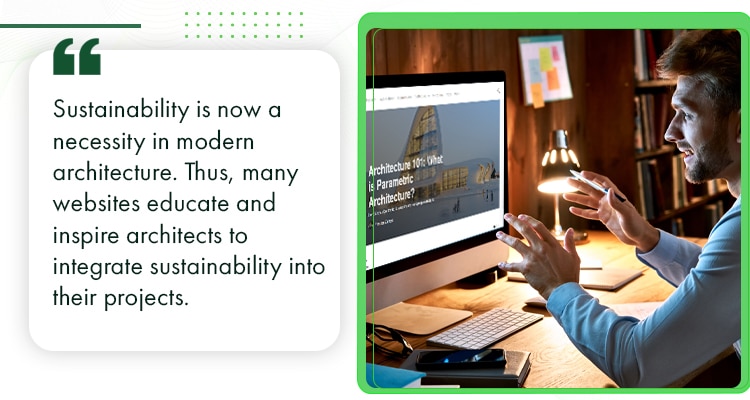
By covering projects like this, the Inhabitat guides architects on how to implement cutting-edge green technologies and design approaches in both residential and commercial projects. It also serves as a valuable resource for those looking to pioneer sustainable architecture in their locations.
#2. Green Building Advisor
Meanwhile, Green Building Advisor provides expert advice, articles, and case studies on eco-friendly materials and energy-efficient construction.
The website often features net-zero energy homes, which produce as much energy as they consume using renewable resources like solar and wind power. These case studies encourage architects to explore alternatives and push the limits of energy-efficient residential design.
By offering practical resources and an in-depth discussion on green building techniques, Green Building Advisor helps architects make better informed decisions in developing sustainable projects.
#3. Build It Green
Another great example is Build It Green, a website that equips architects with tools for making sustainable design choices in both residential and commercial projects.
For instance, the website often features retrofitting projects, where older buildings are upgraded with eco-friendly technologies like water-saving systems, solar power, and green insulation materials. This encourages architects to come up with ways to make existing structures sustainable.
#4. Living Future
Living Future, on the other hand, encourages architects to design regenerative structures. Like the other websites in this category, this site advocates for buildings that produce more energy than they consume and have a positive impact on their surroundings.
It promotes projects like the Omega Center for Sustainable Living in New York, which generates its own energy and treats wastewater using natural systems.
Through its platform, Living Future inspires architects to embrace regenerative and net-positive design principles. It also provides extensive case studies that challenge the status quo of sustainable architecture.
#5. ArchDaily
ArchDaily is a leading architecture website with a dedicated sustainability section that showcases eco-friendly projects worldwide. Many architects turn to ArchDaily for inspiration on sustainable urban planning and renewable energy.
ArchDaily highlights projects like the Bosco Verticale in Milan, which features two residential towers adorned with over 20,000 plants and trees. This greenery helps reduce carbon dioxide emissions and improves local air quality.
By providing unique case studies, ArchDaily positions itself as a key resource for architects seeking inspiration in green design.
#6. Dezeen
On the other hand, Dezeen curates projects that highlight eco-friendly innovation. As a leading platform for design and architecture, it features interviews with architects dedicated to sustainability.
It features sustainable projects like the Earth House, built from natural materials like bamboo and cob. This design minimises environmental impact and serves as a model for future low-energy homes.
By providing the latest insights, Dezeen encourages other architects and engineers to create structures using sustainable materials and green practices.
Group B: Cutting-edge Digital Tools for Architects
Architecture websites provide more than just insights. Some integrate digital tools such as videos, artificial intelligence, and real-time architectural visualisations.
Here are some examples:
#7. Foster + Partners
Foster + Partners is known for its innovative architecture and sustainable design. Their website has a clean, modern aesthetic that emphasises visual storytelling.
Instead of static images, users can explore the firm’s diverse portfolio through engaging videos and 3D visuals. A standout feature is the interactive project maps, which provide context and detailed information about each project’s location.
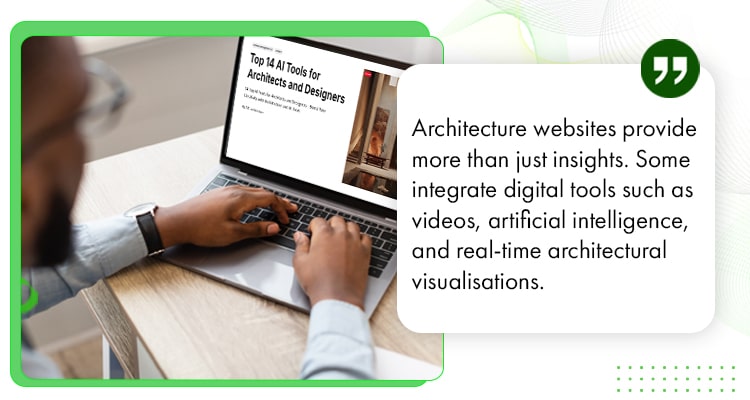
Additionally, the site incorporates advanced navigation tools that guide users seamlessly through various sections, enhancing the overall browsing experience.
This thoughtful design reflects the firm’s commitment to creating impactful spaces – while making their work accessible and engaging for visitors.
#8. NBBJ
Another example is NBBJ, a prominent architecture firm known for its innovative designs focused on enhancing human experiences. Their website reflects this mission with a sleek, modern design featuring high-quality images and videos.
Visitors can immerse themselves in the firm’s diverse portfolio, which includes healthcare, education, and commercial spaces.
A standout feature is the interactive project showcase, allowing users to explore detailed case studies. Additionally, the site has a user-friendly interface that makes it easy to find specific projects or information.
#9. Minale + Mann
Minale + Mann is a top architecture firm with a minimalist website design that features clean visual navigation. The layout showcases large, striking images of their projects, highlighting both aesthetics and functional qualities.
The site includes smooth yet complex animations and transitions that guide users throughout the site. Additionally, its easy navigation and responsive design ensures accessibility across different devices, making it a valuable resource.
The website has been commended by CSS Design Awards and The Drum Design Awards, and nominated for the Webby Awards and Archiboo Awards. These organisations, especially the Archiboo Awards, recognise innovative ways of showcasing notable architecture worldwide.
#10. Dorr
Dorr is a creative architecture office in Dubai with an award-winning website featuring two layers.
Users can toggle between “imagination”, which displays sketches, and “reality,” which shows actual photos of the finished project. The homepage also includes a 3D sketch of the firm’s name, allowing users to play around with it.
By using interactive virtual design tools, website visitors get a unique experience while exploring different architectural styles and layouts.
#11. Mioni
Mioni Architecture, on one hand, uses advanced digital tools to showcase its portfolio, offering an immersive experience on its website.
Visitors can explore 3D renders and interactive models that highlight Mioni’s precise and flexible digital process. The website also offers resources for downloading and webinars on digital tools.
Moreover, the website integrates Building Information Modeling (BIM) software, allowing architects to create highly detailed accurate designs. This improves collaboration and reduces errors.
#12. Studio Reaktor
Studio Reaktor’s site reflects the firm’s innovative approach to architecture. For instance, the homepage grabs the visitor’s attention with a unique, interactive portfolio display.
Projects are displayed using a mix of 3D renderings, photos, and catchy descriptions. The website also features an intuitive layout with smooth transitions, allowing easy access to different sections.
Additionally, the site uses storytelling in its presentation. Instead of long text blocks, it provides short descriptions, letting the photos and 3D renders speak for themselves.
#13. Minuzzo
Italian architecture firm Minuzzo favors a sleek, minimalist website design that reflects its sophisticated architectural style.
The website is user-friendly and offers insights into the firm’s project portfolio. Its homepage, for instance, features luxury residential homes with elegant designs and clean lines.
It also has a digital showroom that leads visitors to a landing page showcasing the project highlights and details.
#14. Includi Architecture
Meanwhile, Includi has a vibrant and engaging website that reflects its focus on creating inclusive spaces. The site greets users with appealing graphics and snappy messaging.
As you browse the website, you’ll see a mix of videos, images, and 3D renders. Creative animations and transitions also enhance the visitor experience, making it more engaging.
The website also shares the firm’s design thinking approach, requiring architects to “imagine, navigate, position, artify, construct, and test.” This unique, personalised design approach helps the firm create designs that fit the needs of their target audience.
Overall, Includi’s website is a welcoming digital space that reflects its commitment to enhancing public life through thoughtful design.
Group C: Virtual Reality and Immersive Experiences
Architecture websites are also evolving to include virtual reality (VR) and immersive experiences.
With VR integration, firms can provide 3D visualisations of projects, allowing users to understand spatial dynamics, materials, and design elements in ways that traditional renderings or static images can’t match.
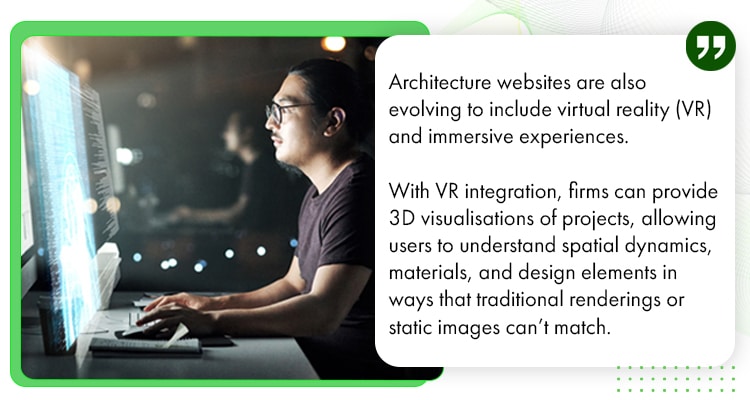
Here are some websites that feature immersive experiences:
#15. Populous
Populous takes a creative approach to offering unique, immersive experiences for its visitors.
The homepage, for example, gives an overview of its projects but uses a distinct style to introduce projects from around the world. Rather than using a simple list or photo gallery, Populous features a 3D globe.
Clicking “Start Experience” takes visitors to a landing page where the globe shows the locations of each project. Visitors can also rotate and move the globe to explore different locations.
This creative integration of 3D visualisations is a powerful way of demonstrating the firm’s commitment to innovation. It also provides users with an engaging and interactive experience.
#16. Museu das Toninhas
Musue das Toninhas’ website proudly displays its architecture by offering visitors a virtual reality experience.
By clicking “Enter the Museum”, visitors access an immersive interface that offers two distinct VR experiences: one for exploring the museum itself and another for observing dolphins in their natural habitat.
The site’s virtual reality feature is designed to be accessible through standard web browsers, allowing a wider audience to engage with its offerings without specialised equipment.
#17. Showroom by Little Workshop
The Showroom is a website that uses WebGL technology to create a 3D virtual space, letting visitors explore it as if they were there in person.
Users can move around the 3D space, interact with objects, and view it from different angles. This immersive experience gives users a sense of scale and detail that static images can’t match.
Additionally, the website’s VR integration works through the browser, so users don’t need to install additional software or hardware to interact with the 3D space.
#18. Natadesa Endek
Natadesa Endek is another impressive project that uses virtual reality in architecture. The website lets visitors take an interactive tour, allowing them to “walk through” the building, and even explore the second floor.
The virtual tour uses high-definition panoramic images, offering a 360-degree, up-close view of the rooms. This immersive experience gives a better understanding of the building’s design and architecture.
The Natadesa Endek virtual tour demonstrates how immersive experiences can enhance modern architecture using advanced technology, making it engaging and accessible to both architects and enthusiasts.
Group D: Showcasing Global Architectural Projects
Many architecture websites provide architects with insights from global projects They share blogs, feature projects, and give detailed descriptions of various architectural designs.
Some also highlight the ingenuity behind iconic buildings, new developments of AI in architecture, and sustainable building practices in response to climate change.
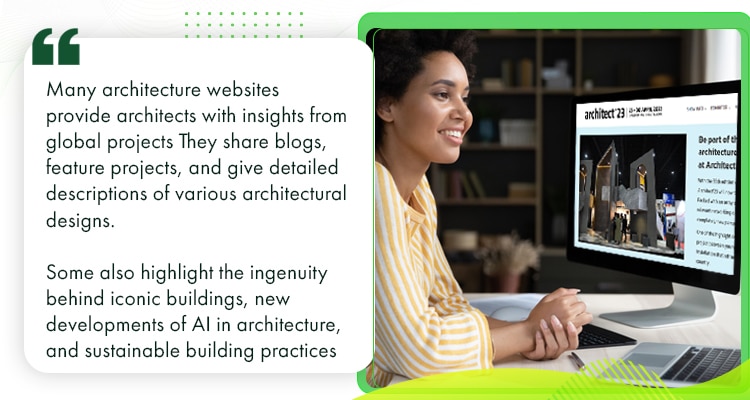
Let’s take a look at some websites that showcase global architecture projects.
#19. Dwell
Dwell is a design and architecture website that features a carefully chosen collection of homes from around the world. It focuses on the projects’ livability and aesthetics, making it a great resource for anyone interested in modern residential architecture.
It features projects from regions like North America, Australia, Asia, and Europe. Each article covers the design philosophy, construction process, and distinctive architectural features.
Dwell often highlights how architects from different countries are influenced by global design movements like minimalism, Scandinavian design, and even mid-century modern architecture.
It also examines new global design trends, including prefab construction, modular homes, and biophilic design.
#20. Architizer
Architects also frequent Architizer, one of the leading platforms in showcasing innovative architectural projects worldwide.
It has a comprehensive profile of different projects, including descriptions of the design concept, materials used, challenges faced, and the architectural team involved.
Additionally, Architizer’s A+ Awards lets the architecture community and the public recognise and celebrate architectural projects worldwide. The awards are bestowed on outstanding projects globally, often highlighting innovative and creative designs.
#21. Contemporist
Contemporist focuses on contemporary design and architecture. It often features global architectural projects that use sustainable materials for residential, commercial, and public spaces.
The website highlights both established and emerging architects, promoting a diverse range of styles and influences from around the world.
By featuring projects from different regions, Contemporist gives architects a global perspective of architectural trends and insight into how cultural contexts influence design.
#22. Archello
On the other hand, Archello takes a project-focused approach to featuring global architectural projects. It covers industry news, events, and exhibitions, providing visitors with the latest information on architectural innovations.
The website features projects from Shanghai, Argentina, Vancouver, and Paris, among others. It also provides information about each project, giving visitors insights into the creative processes, challenges, and decisions involved in each building’s design.
#23. Archinect
Many architects visit Archinect, an online platform that aims to bring together designers from around the world and introduce them to new ideas from all disciplines.
The platform offers insights into the challenges and solutions of different projects, ranging from small experimental homes to large urban planning efforts.
For example, it featured the V&A Dundee, designed by renowned architect, Kengo Kuma. The Scotland-based museum blends seamlessly with its surroundings, with a structure that mimics the cliffs along Scotland’s coast, which Archinect explored in detail.
By covering projects like V&A, the website helps readers see how global architecture impacts not only a region’s infrastructure but also its social and economic development.
#24. World Architecture News
As a global platform, World Architecture News (WAN) provides architects, urban planners, and design enthusiasts insights on public spaces and sustainable architecture.
The website features projects like The Edge, an office building in Amsterdam designed by PLP Architecture. Known as the most sustainable office building in the world, The Edge uses advanced technologies to reduce energy consumption.
With detailed write ups and expert commentary, WAN highlights the architectural and environmental challenges of global projects like The Edge. It also demonstrates how design can meet modern sustainability needs without compromising functionality and aesthetics.
#25. Designboom
Lastly, Designboom covers architecture and other design fields like art and technology. As a globally-recognised platform, it highlights architectural projects that intersect with art, urban planning, and technology.
The site offers a unique global perspective, showcasing everything from rural homes to massive urban projects. For example, it featured the Wooden Skyscraper in Tokyo and Beijing’s National Stadium (Bird’s Nest).
In addition to featuring aesthetic appeal, Designboom highlights environmental features such as energy-efficient systems. This helps readers appreciate the architectural brilliance behind each project and its impact on cultural identity and environmental responsibility.
The Role of Websites in Modern Architecture
Modern architecture websites are essentially architecture design platforms that showcase portfolios, promote firms, and share innovative ideas.
Websites also allow architects to display their projects, attract new clients, and connect with a global audience. Some even go further by offering virtual tours and interactive models, letting online visitors experience designs before they’re even built.
Importance of Virtual Spaces for Project Showcases, Community Engagement, and Client Interaction
Virtual spaces, or computer-generated environments, offer architects and firms dynamic platforms with which to present their work. They can use virtual tours and interactive 3D models to help clients better understand the design’s intent and functionality.
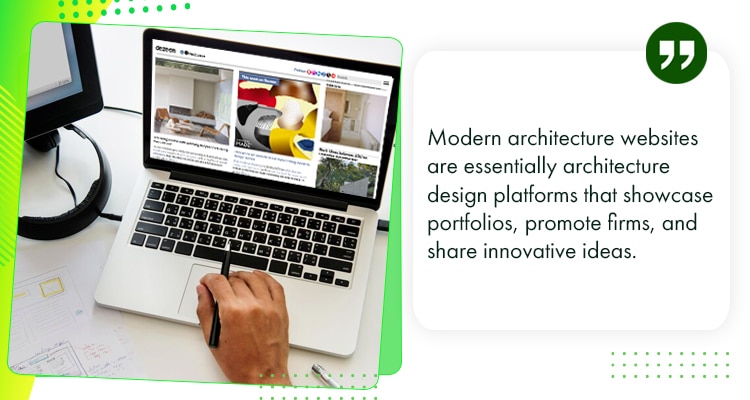
Virtual spaces also include online forums and social media platforms where architects can gather feedback from different audiences.
These channels encourage discussions about design, sustainability, and urban planning. Done right, it fosters trust and transparency, which leads to more successful and satisfying project outcomes.
How These Websites Impact the Future of Design Thinking
In the age of artificial intelligence, architecture websites play a crucial role in shaping the future of innovation and creativity. These platforms show groundbreaking projects and the processes, challenges, and solutions behind each structure.
By providing access to diverse perspectives, resources, and emerging trends, these 25 architecture websites empower architects to push the boundaries of traditional design.
Influence on Education and Professional Development
Many of these architecture websites are valuable resources for professional architects, students, and educators alike.
They provide case studies, design critiques, and architectural theories, enabling aspiring architects to explore different styles and methods outside the classroom.
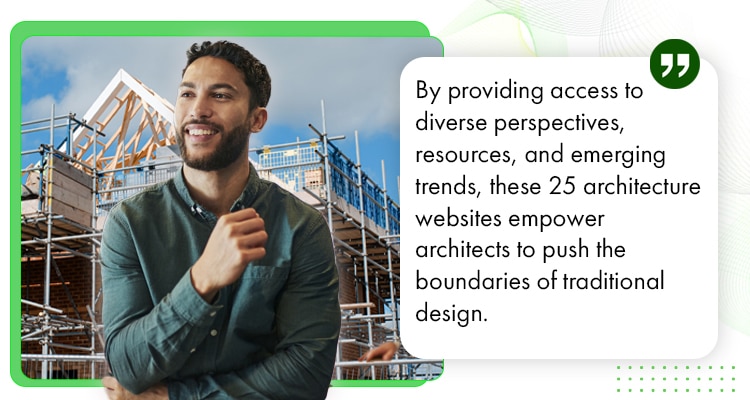
Exposure to these global architectural projects online enhances students’ understanding and inspires innovative thinking – even without having to travel to different parts of the world.
Long-Term Effects on Architectural Trends
Websites featuring groundbreaking projects like the ones above encourage architects to integrate eco-friendly elements. Over time, they can help steer architectural trends towards more sustainable and innovative designs.
In addition, they also set new benchmarks for the profession. Featured projects often serve as reference points, inspiring other architects to adopt similar high standards in technology, design quality, and environmental impact.
This ripple effect pushes industry standards forward, encouraging the evolution and adoption of best practices in architecture.
Architects Aren’t the Only Ones Using Architecture Websites for Reference
Although they are called “architecture websites,” these platforms also serve as resources for interior designers, engineers, urban planners, estimators, and even clients.
For non-architects, these websites offer easy-to-understand visual information that connects technical expertise with creative vision. They also provide design references that they can provide architects they hire or work with.
Let’s take a closer look at some examples.
Collaboration Between Architects and Estimators
Estimators provide detailed estimates to help clients set budget expectations for materials, labour, and timelines. They coordinate with engineers, project managers, and architects to ensure accurate projections.

With the help of architecture websites, they can estimate project costs and identify potential challenges and solutions. Articles and case studies from different countries also provide cost-effective alternatives, giving clients more affordable options without compromising quality.
Role of Estimators in the Architecture and Construction Process
Architects rely on estimators to make informed decisions about the costs of materials, structural systems, and design features.
This collaboration helps architects refine their designs to balance aesthetics and practicality. Additionally, estimators conduct value engineering to ensure successful project outcomes while staying within the budget.
The Intersection of Technology and Human-Centric Design
Technology made it possible for architects to build functional designs by providing easier access to global architectural trends.
As technology continues to advance, architects and designers will also have more competencies to improve their design process and in turn, user experiences.
Technology’s Role in Design Thinking
Design thinking always considers the end-user – and technology makes it easier.
Architects prioritise user needs and experiences in the design process. This is easier done with the help of digital tools like 3D modeling architecture software, virtual reality, and augmented reality. These technologies allow designers to visualise better ideas and get more real-time feedback on how users will interact with spaces.

Digital platforms like project management software and communication tools also make collaboration easier. They enable a seamless exchange of ideas between designers, architects, and other stakeholders.
Focus on Human Needs
With real-time data and simulations, designers can predict user behaviours, test layouts, and refine designs to improve functionality and personal satisfaction.
This process relies on constant feedback to integrate user needs throughout. As a result, architectural spaces are not only visually appealing but also responsive to their users’ emotional and physical needs.
Emerging Trends in Architecture Driven by Digital Platforms
The rise of online platforms, artificial intelligence, and data analytics has transformed architectural practices, making them more responsive, sustainable, and user-focused.
With technology making unique and transformative programs accessible, architects are inspired to create something new as well.
Adaptive Reuse and Modular Construction
Adaptive reuse is the process of repurposing existing structures for new functions. This approach promotes sustainability by minimising waste and conserving resources.

On the other hand, modular construction simplifies the building process using prefabricated and standardised components. This approach speeds up construction and creates spaces that are functional and responsive to urbanisation challenges.
Both trends highlight the ongoing shift towards sustainability, efficiency, and innovation in architecture.
Trends’ Alignment with Broader Movements
As environmental concerns grow due to the worsening effects of climate change, the architectural community is increasingly committed to reducing its carbon footprint and minimising waste.
Trends like adaptive reuse and modular construction complement green architecture, which emphasises environmentally responsible design. They also relate to energy efficiency, sustainable materials, and the integration of renewable energy sources.
Together, these trends reveal a growing emphasis on resilient design, focusing on the need for adaptable spaces to address climate change and shifting demographics.
Frequently Asked Questions (FAQs)
The following are some of the most frequently asked questions about architecture websites:
#1. What Kind of Digital Tools Do These Architecture Websites Use?
Architecture websites use digital tools to enhance design processes, facilitate collaboration, and showcase innovative projects, these include:
- Building Information Modeling (BIM) – This allows architects to create detailed 3D models that integrate structural, mechanical, and electrical components.
- Autodesk Revit – It enables architects to visualise designs and detect potential issues early in the process.
- SketchUp Viewer – This virtual reality software allows users to walk though 3D models in real time, making it easier to understand spatial and design intentions.
- Trello – Collaboration tools like Trello facilitate project management and communication among architects, engineers, estimators, and other team members.
- Material Bank – This design database offers architects a vast array of sustainable materials and innovative design elements.
#2. How Do Websites Enhance the Understanding of Client Needs in Architectural Projects?
Interactive features like virtual tours and 3D visualisations on websites give clients more informed feedback. They provide a clearer picture of the space, layout, and functionality, leading to more productive discussions with their architects.
Moreover, featured blogs and articles often address common client concerns. This helps them understand what is possible and reasonable within their budget.
In addition, educating clients about sustainability practices encourages them to support green architecture, whether they are building their homes or expanding their business offices.
#3. How Do Architecture Websites Support Innovation in Urban Planning?
Architecture websites serve as valuable resources that inspire urban planners, architects, and policymakers to think creatively about the challenges facing modern cities.
They also showcase the best architectural practices from other countries through articles, case studies, and research papers.
Some websites even host forums and discussion boards where professionals can exchange ideas, collaborate on projects, and discuss emerging trends in urban planning.
Conclusion
Architecture websites are redefining design thinking by integrating technology, enabling architects to improve their craft and better serve the needs of the people they design for.
These digital platforms connect architects from different parts of the world, encouraging them to learn from one another and promote sustainability and resilience through innovative designs.

So, if you’re an architect or aspiring to be one, these top 25 best architecture websites can enrich the way you – and your design – can contribute to the evolution of architecture in this rapidly changing world.
Looking for estimators to help bring your architectural vision to life in Australia? Click here.
Click here if you’re looking for world-class remote workers to help you stay on top of your construction projects.
If you’re ready to experience the full advantages of working with a top global team, check out our 1,000 fully vetted and highly talented staff here.
Syrine is studying law while working as a content writer. When she’s not writing or studying, she engages in tutoring, events planning, and social media browsing. In 2021, she published her book, Stellar Thoughts.




















